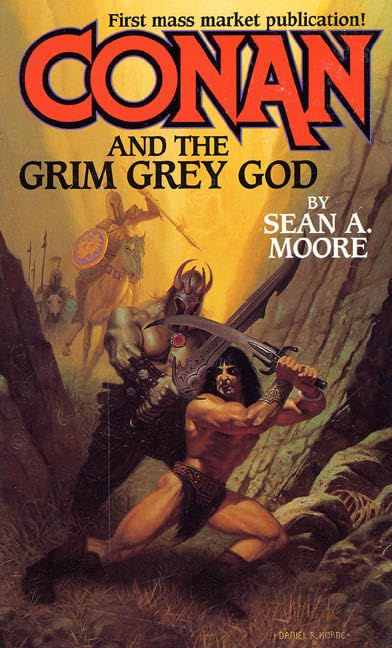Conan is no Marcher of Valhalla
- Greg O'Driscoll
- Jan 31, 2024
- 4 min read

"The City in the Storm" was written by Roy Thomas, drawn by John Buscema, and inked by Ernie Chan (formerly Chua, see the letters page for details, the reader is instructed). Like many of these early Conan adventures it is adapted (this time in a quite heavily altered form) from one of Robert E Howard's non-Conan tales. In this case, the inspiration is Marchers of Valhalla, one of my favorite Howard stories. By way of proof, I offer this picture of a shelf in my office at work where the hardbound edition of Marchers of Valhalla holds pride of place. The image of the red-haired giant is nothing like how I imagined him upon reading the tale, but I still like displaying it.

As for the change from Chua to Chan, after leaving Marvel for a bit (working on Claw the Unconquered among other things) Ernie became a U.S. citizen and decided to start over with a new name. Artwise the new Mr. Chan really pulled out all the stops for his return issue.
In the original tale, a young but old beyond his years James Allison encounters a mysterious woman that triggers an ancestral memory trip of his past life as a warrior named Hialmar. Obviously, the ancestral memory component in unnecessary when making Marchers into a Conan story. Conan already exists in a prehistoric era. A case could be made for Conan remembering a past life as his ancestor King Kull of Atlantis, but why complicate things? The power of the original story is that James Allison, who walks with a cane and is bitter about it, was once the mighty warrior Hialmar. That doesn't really work with Conan.
Hialmar is one of a race of proto-Nordic wanderers called the Aesir. They cross a prehistoric land bridge and wind up in a region of North America that will one day become Texas (no, seriously). There they discover the ancient city of Khemu and rather than sack it like they have every other city they have encountered, the elders of the warrior host consent to being hired as mercenaries. You see, the city's inhabitants have enemies.

In the comics, these enemies are the Barrachan pirates, famous freebooters and sea-raiders from the islands off the coast of Argos (I thought they were off the coast of Zingara, but even a continuity junkie like Roy Thomas can make mistakes) and they fold up pretty easily in spite of their golden-haired leader Auro being mentioned by name and getting away to fight another day.
Howard's story featured a red-haired warrior with no name. He was one of the Vanir, the Aesir's hereditary enemies, and somehow he rose to a position of leadership over a tribe of black warriors with an armada of canoes. Yeah, it's typical white man awes the natives stuff, but we never get all the details. Somehow, the limited info we are given about the nameless Vanir and his rise to power makes him more intriguing an enemy than Auro:
"Up the passes swarmed the chanting, painted warriors, and at last we saw their king, towering above the huge figures. the morning sun caught his hair in a crimson blaze, and his his lAughter was like a gust of the sea wind. Alone of that horde he wore mail and helmet, and in his hand his great sword shone like a sheen of silver. Aye, he was one of the wandering Vair, our red-haired kin in Nordheim. Of his long trek, his wanderings, and his wild saga, I know knot, but that saga must have been wilder and stranger than that of Aluna's or of ours. By what madnes in his soul he came to be king f these fierce savages, I can not even offer a guess. But when he saw what manner of men confronted him, new fury entered his yells, and at his bellow his warriors rolled up the runways like steel-crested waves."

Suffice it to say, after Conan and Belit run off Auro and the Barrachan pirates, they are welcomed into the ancient city. The inhabitants turn out to be as treacherous as the city-dwellers in the original, which leads to a classic cliffhanger ending courtesy to some drugged wine. Conan and company are lucky. In the original, the treacherous hosts give the Aesir deadly poison, not s sleeping potion. Next up for Conan and Belit? The sacrificial altar!
Honestly, this adaptation, repurposing, or whatever you want to call it, was unneeded. It just doesn't pack the punch of the original. James Alison relives the death of his past self, who dies not by poison but pushes through his fatal wounds to achieve vengeance just prior to the total destruction of the city.
The final fate of Hialmar, which Conan and Belit will obviously escape, is one of the finer and more tragic moments in Howard's writing. I have always found this moment, which spurs the young warrior to his last heroic act of violence, strangely touching:
"I sank down upon my knees beside the altar and, groping hesitantly about her slender form with my arms, I kissed her dying lips, clumsily, falteringly, as acallow stripling might have done. that one act-- that one faltering kiss-- was the one touch of tenderness in the whole, hard life of Hialmar of the Aesir."
How unutterably sad is that last sentence! I would love to link to a full online text for Howard's Marchers of Valhalla as I have been doing with other non-Conan tales that Roy Thomas adapted into Conan comics, but this one appears to not yet be in the public domain for some reason. It has been reprinted a few times, so hit up eBay or the local bookstore.



Comments